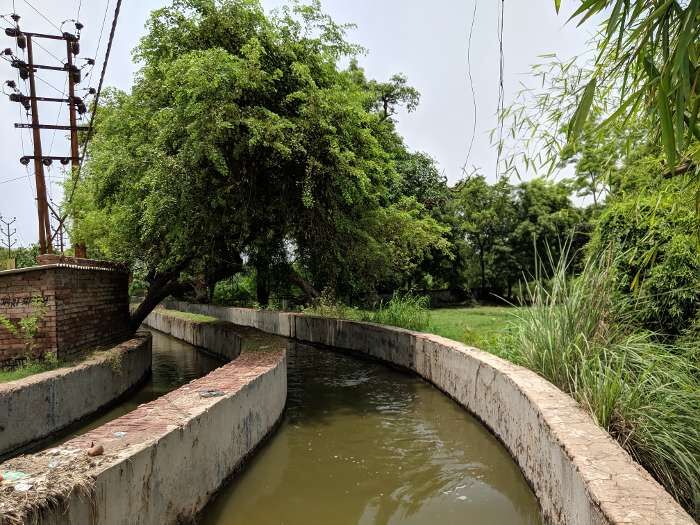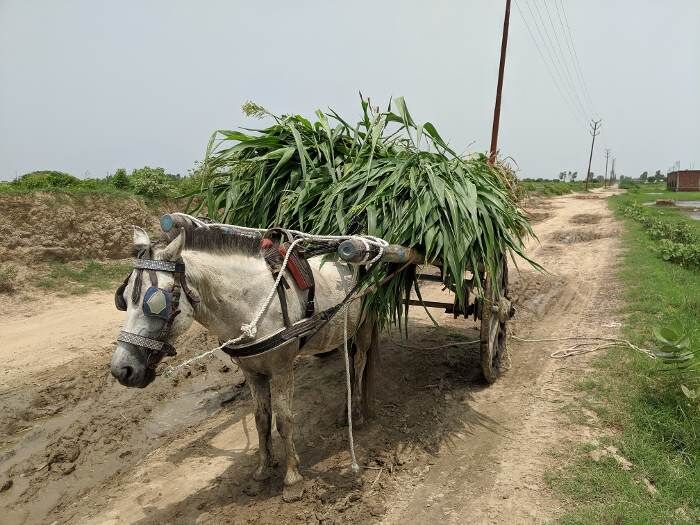Ranvijay Singh/Mithilesh Dhar Dubey
In the canal adjoining the road, flows foamy yellowed water which reeks rotten. In the Jajmau district of Kanpur, farmers of several villages irrigate about 300 hectares of land using the same water.
Sitting by the canal, Sonelal Yadav, 50, from Peondi village of Jajmau said: “Dirty water from the tanneries and sewerage is treated and sent to us for irrigation. This water has destroyed our crops. Having no other means of irrigation, we have to resort to its use. This chars our fields and we are unable to grow anything to eat but are helpless.”
Farmers from several adjoining villages of Kanpur’s Jajmau suffer like Sonelal Yadav. The reason for their problem is the irrigation channel set up in the area which provides the water for irrigation. The water which is pumped from the tanneries and the city’s sewerage to Common Effluent Treatment Plant (CETP) gets treated there and directed to the irrigation channel for irrigating in the locality.
Till 1994, the water in the irrigation channel was mixed with the water drawn from the Ganga. This water had essential minerals to produce a good crop. Thereafter under Ganga Action Plan Phase I, a Common Effluent Treatment Plant (CETP) was established in Jajmau which brought out a complete change in the composition of water directed to the irrigation channel. The channel now doesn’t have water from the Ganges, but only which is treated and has chemicals like arsenic, chromium, mercury, and lime which harm the fields and crops.

Another farmer from Peondi village, Suryakant Yadav, 45, said: “Previously, Jajmau didn’t have so many tanneries, Also, the water from Ganga was sent to us mixed with sewerage, which benefitted our crops. However, with the increase in the number of tanneries the situation has altered.”
Suryakant informed, “Previously this area used to grow roses so abundant that a bigha yielded 1.25 quintals. Now one wouldn’t even find roses enough for puja. Those days we produced good roses and earned good profits. The entire family used to work in fields. Now village folks head to the tanneries for work because this water has not only spoiled the crops but also the soil.”
It is not uncommon to find most of Uttar Pradesh sowing paddy during July, but Jajmau sows the only jowar instead. Telling the reason behind it Sonelal Yadav said: “Local farmers don’t grow anything for their private consumption from the channel’s water. Even if they do so, the crop fails anyway. In summer, this water becomes so toxic that it can easily burn any crop except the study jowar. Jowar is an easy crop to grow and keep, it can be fed to animals and sold to earn some money.” Sonela further informed that all adjoining villages in the area, including Peondi, Sheikhpur, Jana, Madarpur, Trilokpur, and Mawaiya irrigate their field with the water from the channel.
It is not as if people have not protested against the situation. The villagers complain time and again but the matter remains unresolved. Also, a public hearing took place in 2002 to address the issue which was well attended by the people so affected, Kanpur’s deputy mayor, scientists from IIT-Kanpur and the officials from Central Pollution Control Board.
In the public hearing, the survey reports of the Eco Friends organization and IIT-Kanpur were presented. The reports hand mentioned that besides the water supplied for irrigation the groundwater of the area also is bad. The groundwater from Wajidpur and Sheikhpur villages of Jajmau had a dangerously high level of Arsenic, Cadmium, Mercury, Nickel, Chrome-VI, Endosulfan, and Didilrin.

It was decided in the public hearing that tanneries’ waste shall not be flown in the irrigation water but nothing of the sort happened. Eco Friends’ executive secretary, Piyush Jaiswal informed, “A few actions were taken following the public hearing. Deep boring was undertaken in numerous villages and tanks were installed to provide clean drinking water to people. It did work out for some time but then bores dried out somewhere and the machine broke somewhere else. The way all government work happens, the same way it worked here.”
“So far as irrigation-water is concerned, till the time waste comes out of tanneries it will be treated and sent to the channel. Farmers are helpless because even if they refuse this water it would still seep into their fields.”
It is prudent to inquire about the quantity of treated water being flown into the channel. Jal Nigam’s Project Manager Ghanshyam Dwivedi said: “Daily Jal Nigam flows 150-160 MLD (megalitres per day) of treated water in the channel. This water is used for irrigating the 300 hectares area. Throughout the year, the farmers use it for irrigation. If they don’t, we divert it to the nullah.”
Meanwhile, many people like Sonelal and Suryakant Yadav are using the same water for farming. Though they don’t raise their food with it, their animals are getting sick due to the feed and the diseases, in turn, are transmitted to humans through their milk. Moreover, the green toxic water spread over fields emits foul smell which is giving rise to respiratory ailments. For people, this situation has become insolvable.
Also Read: Four months a year, solar pumps for irrigation remain idle in drought-hit parts of Maharashtra
Also Read: Ever eaten veggies grown in “black and red” chemical water? People in Gujarat are eating




















